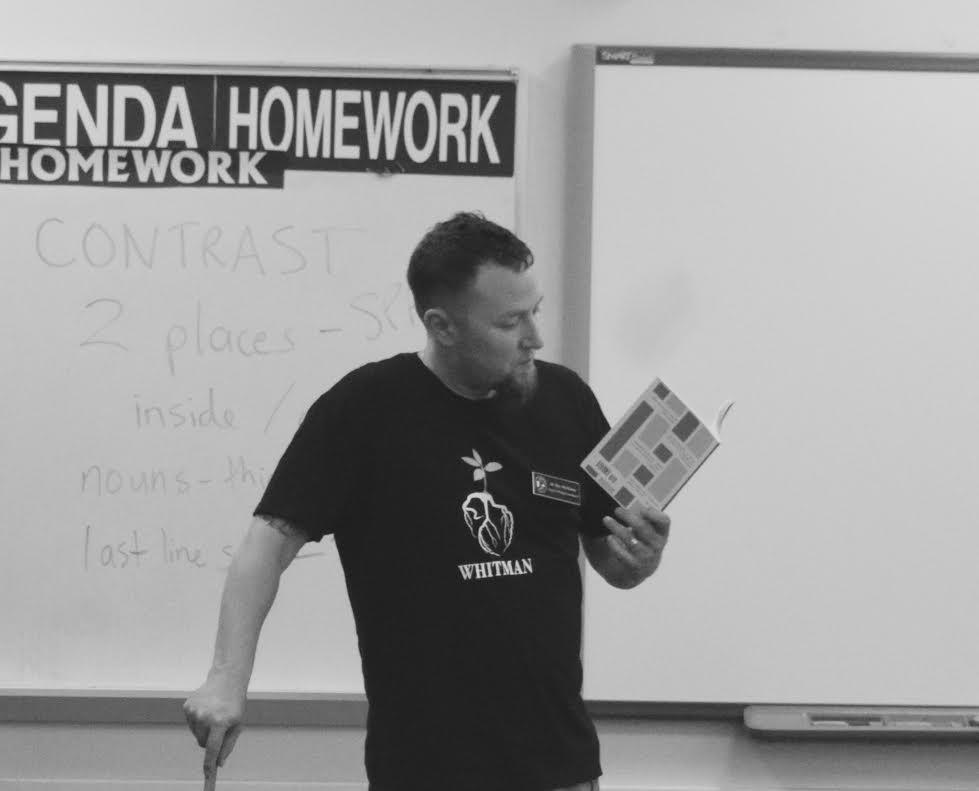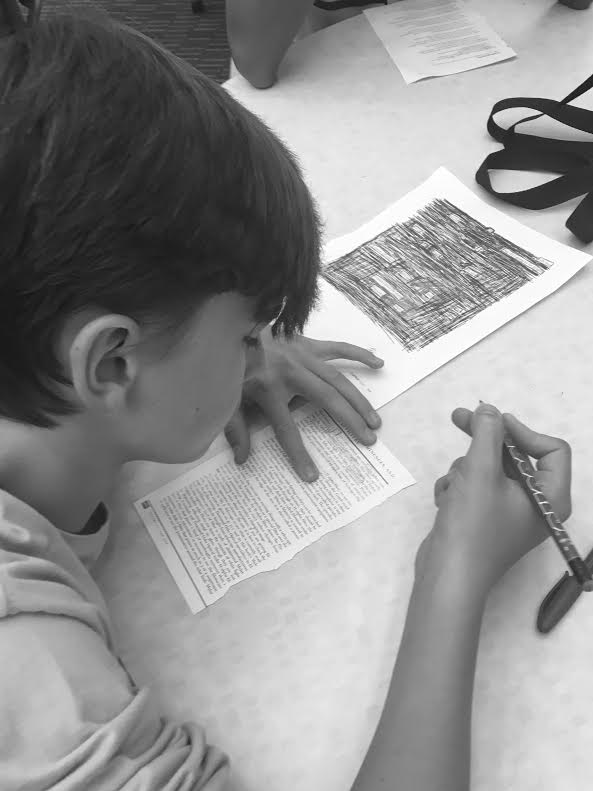This afternoon, it’s round two of Haiku Death Match. The topics are deodorant and cheese. The first round included haiku on Beyoncé and the beard of Darien Cavanaugh, one of the writing instructors. The instructors write all sorts of topics on strips of paper—not just deodorant and cheese but French fries, love, bad smells, puppies. These topics are drawn from a bucket. The teams have 2 minutes to write. They have given themselves team names—the Argonauts, NerdHerd 3.0, the Curators, Tomatoes. When time is called, someone from each team reads the haiku aloud—twice—for the judges.
Right, judges. First there is the Panel of Death, a collection of mostly older students, who vote on the haiku. Someone inevitably brings up questions of accuracy: what was the syllable count? how many syllables in “easily”? One reader explains that when he read: “Odor: / say your prayers now,” “Odor” was the end of the second line. Someone else shouts out: “That’s enjambment!” (Yes! They got the lesson on line breaks in poetry!)
If there is a tie, the decision goes to the Titans (the instructors). And if there’s a tie among the Titans, well, bring out the Kraken—i.e. fiction instructor Cavanaugh, who will roar appropriately then vote thumbs up or thumbs down. “Kra-ken! Kra-ken! Kra-ken!” they chant.
At some point, we usually ask that the haiku be sung. For clarity, of course.
~
At the Tri-District Arts Consortium, or Tri-DAC, I’m teaching creative writing along with a staff that continually amazes me and makes me laugh. (And luckily, someone is usually ready to make a coffee run when it’s the needful thing.) The three-week summer program includes music, theatre, dance, visual arts, and creative writing. Students audition to participate. In creative writing we have about 50 lively and engaged students, rising 6th graders to rising 9th graders, some who have been here all four years.
In the Creative Writing Program (see our website here), practicing South Carolina writers teach essentials of creative writing from page to stage with exercises that promote creative development, revision, and performance. Along the way, students learn more than just how to become better writers—they also develop skills in effective communication, empathy, teamwork, and confidence.
Students in creative writing this year are taking poetry classes with me and with Betsy Breen, a poet who teaches at Hammond School; prose classes with Darien Cavanaugh, named the Jasper Artist of the Year a few years ago after he founded the Columbia Broadside Project; and classes in flash fiction and memoir with visiting artists Justin Brouckaert, a recent USC MFA graduate; and Carl Jenkinson, who teaches writing now at the Moore School of Business. Past instructors and guest artists have included: Will Garland, Lindsay Green-McManus, Jonathan Maricle, Wendy Ralph, and Mark Sibley-Jones (who now teaches at the SC Governor’s School for the Arts). The whole endeavor is directed by Ray McManus, a poet on faculty at USC-Sumter who has an extraordinary ability to hold the attention of 50 rowdy middle schoolers. Haiku Death Match was his idea for the late afternoons in the last week, when the instructors are getting a little punchy and the students are at their giddiest. After two rigorous weeks of classes and daily writing activities, it’s a fun group activity that is collaborative and, despite the silliness, one that has students thinking about what makes a poem good, what makes a poem work.
~
Dr. Ray’s 8-10 Rules of Writing
- Do not ask yourself if you should disturb the universe. Instead ask yourself how.
- Rhyme is fine some of the time, but mostly it’s stupid.
- Editing is not the same as revising.
- No senseless writing.
- There is no such thing as writer’s block. There is no such thing as writer’s block. There is no such thing as writer’s block.
- When in doubt, say something outrageous.
- Typing is not writing.
- In writing there is no right or wrong, there is only weak or strong.
The students know these rules. They can recite them. In unison. With enthusiasm.
~
Some of us have been working with Tri-DAC for years, some for the first time this year—but every year is really a first time, as we learn to work with each other and with a range of new and returning students, adapting our exercises to what other instructors are doing, and maybe trying to emphasize lessons students are learning in other classes. (Besides, if we reuse an exercise, returning students will let us know: “we did that last year!”)
Along with my class, my job the past few years has been the mini-showcase, a performance that falls at the end of the second week. Each art discipline performs during the showcase, usually highlighting their oldest students, especially the four-year students. I’ve tried to create choral projects, where the students’ voices echo and converse with each other around a central theme or set of prompts. One year we did prayers and curses. (The entire audience moaned when one writer said, “May there be no presents under your tree.”) One year it was a medley of poems about what we keep and how we worship, responding to poems by Naomi Shihab Nye (“Different Ways to Pray”) and Carlos Drummond De Andrade (“The Elephant”).
This year the students read two poems from Welsh poet Jonathan Edwards’ lovely book, My Family and Other Superheroes—“My Family in a Human Pyramid,” in which Edwards imagines his family building an impossible human pyramid, with his diapered godson teetering on top of his head, and “Building My Grandfather,” in which he imagines building his grandfather, one piece, and one story at a time. (Read more about Edwards’ poetry here and here.) So we began to imagine our families as soccer teams and cheerleading squads, as the cast of a play or the staff of NASA (with Grandma flying to the moon with her dogs, because she never goes anywhere without them). And we, too, began to imagine building our grandparents, one piece, and one story at a time.
Here’s “Building My Grandmother” by Zach Frueauf, a rising 8th grader at Carolina Springs Middle School.
Building My Grandmother
by Zach Frueauf
We buy parts with the fifty dollars she gave me for my birthday.
We put her together steadily until we get to the knees,
they are rusty because she has done so much farm work.
We fill her lungs with the smoke she has inhaled from cigarettes.
We fill her heart with a new husband
to make up for the ones she had lost in the past.
We fill her brain with the music of her guitar,
and we put her hands on with care so she can play it.
In Breen’s class, the young writers wrote startlingly rich poems about places they’d been after reading South Carolina poet Terrance Hayes’s “New York Poem” (lightly edited for middle school students), and they produced amazing mythic versions of their own births after reading Alma Luz Villaneuva’s “Indian Summer Ritual.” (One of our twin writers, Isaac Hill, wrote, in one of the loveliest birth poems, “I let Joe go first / He kicked me in the head. / It left no mark.”) They also learned about showing not telling, about the value of specificity, while writing poems after reading Edward Hirsch’s “Cotton Candy.” Breen asked them to write a poem about the last time they saw someone that they care about—“someone you haven’t seen in a long time.”
Here’s “Sharing a Coke” by Mara Lind, a rising 9th grader from River Bluff High School.
Sharing a Coke
by Mara Lind
I didn’t recognize you,
with a black shirt, dirty hair, and stubble.
You opened a coke but didn’t offer me one,
so I got my own,
sipping slowly.
Someone brought a radio and
the uncles danced with aunts.
My drink fizzed warm in my
stomach while we hid behind
hay stacks. You didn’t talk much.
I asked about school and
you answered.
When saying goodbye,
I had to stand tall to hug you,
and the pop tab fell between my fingers.
Cavanaugh gets the students to create their own biographies based on a poem by George Ella Lyon, “Where I’m From,” as well as wacky little nonfiction pieces based on comedian Sara Silverman’s “Two-Minute Index” featured on the sides of Chipotle cups in their “Cultivating Thought” series. These are crazy fun.
~
Two of the boys are always farting. One little girl has the whiniest voice I’ve ever heard, almost like fingernails on a chalkboard. If we don’t marshal them into Haiku Death Match, the room can devolve into arm-wrestling and discussions of how to talk like Yoda. Matthew wants to show us card tricks. Samantha drew a picture of me. Trevor tried to explain Pokemon Go to me. One day Scott brought his entire library of Animorphs books. On birthdays, we often have cupcakes.
It’s exhausting and exhilarating and every year I leave so thrilled to have been part of it.
And Friday night, July 15, we’ll have our final program. The music and creative writing programs will perform together at 6:30 at the Lexington One Performing Arts Center. Theatre and dance and visual arts have their final performances and presentations Saturday at Richland Northeast High School.
TriDAC is in its 31st year, the creative writing program in its 21st, the last 11 directed by McManus To find out more about the creative writing program at Tri-DAC, check our website at www.cwtridac.com.












